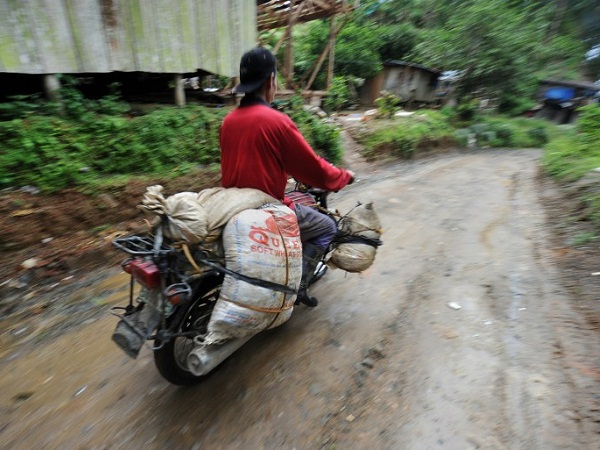Mindanao to get biggest infra budget in 2013

This photo taken on July 17, 2012 shows a motorcycle driver maneouvering through a slippery road as he transports sacks of ore to be processed for gold particles at a mining site in the village of Mt. Diwata, in the town of Monkayo in the Compostela Valley, on the southern Philippine island of Mindanao. AFP/TED ALJIBE
MANILA, Philippines—For the third year in a row, strife-torn Mindanao will get the biggest slice of the government’s infrastructure budget pie in 2013, according to the Department of Public Works and Highways (DPWH).
In a DPWH report furnished to the Philippine Daily Inquirer, the agency has disclosed that of its 2013 infrastructure program budget of P106.2 billion, the southern Philippines has an allocation of P27.6 billion, or 26.09 percent of the funding.
On the other hand, the other regions will get the following allocations next year: Metro Manila, P14.6 billion; Northern Luzon, P24.1 billion; Southern Luzon, P20.4 billion; and Visayas, P19.4 billion.
During the past two years, the DPWH has set aside P42.1 billion for infrastructure projects in Mindanao, followed by Northern Luzon with P39.3 billion; Visayas, P31.2 billion; Southern Luzon, P30.2 billion; and Metro Manila, P17.2 billion.
“Out of the P42.1 billion allocated to Mindanao in 2011 and 2012, P6.2 billion was set aside for infrastructure development in the Autonomous Region in Muslim Mindanao. An additional P2.4 billion for the ARMM is proposed in Fiscal Year 2013,” noted the DPWH.
In the 2013 budget, ARMM provinces, said to be among the poorest areas in the country, will have the following allocations: Maguindanao, P962 million; Lanao del Sur, P557 million; Basilan, P431 million; and Sulu, P300 million;
In the same report, the DPWH said “the national government has prepared a ‘Stimulus Development Plan,’ or SDP for the ARMM, which aims to implement its reform road map towards economic recovery and development in the region.”
“Under the plan, the government will fund priority and strategic projects promoting basic services, infrastructure and livelihood development that have been identified by various national agencies. The development of national roads is one of the highlights of the plan,” it also said.
The DPWH, designated as the lead agency in implementing the SDP, has created a task force to oversee its implementation.
Late last year, Malacañang approved the release of P2.85 billion for the rehabilitation and upgrading of various national roads and bridges in the ARMM.
In June, the DPWH completed the rehabilitation of at least 31.2 percent of 127.7 kilometers of road and 16.7 percent of 132.3 linear meters of bridges in the region.
The roads include the Basilan Circumferential Road in Basilan; Jolo-Taglibi-Tiptipon Road and Jolo Port-Romandler Road, both in Sulu; Bongao-Nalil-Road and Bongao-Pahut Road, both in Tawi-Tawi; Molundo-Wao Road, Ganassi-Tubod Road and Marawi-Malabang Road in Lanao del Sur; and Midsayap-Dulawan-Makar Road, Cotabato-Lanao Road and Kidapawan-Ala Junction Road, all in Maguindanao.
The bridges include the Gubawan in Basilan; Bato-Bato and Kiaokaran, both in Lanao del Sur; and Pagatin and Matilak, both in Maguindanao.
Meanwhile, at least seven World Bank-assisted national road improvement projects in Mindanao have yet to be completed, according to the DPWH.
They include, among others, the 53-km Digos-Cotabato City Road (Kidapawan City section) and the 50-km Digos-Cotabato City Road (Pangalungan section), which are 28.6 percent and 19.4 percent complete.
Two other road projects – the Kapatagan and Parang sections of the Cotabato-Marawi City Road – are “undergoing pre-construction activities.”
Early next year, three Asian Development Bank-funded road projects are “ready for roll-out,” said the DPWH, They are the 20.7-km Dipolog-Oroquieta City Road, which has a budget of P175.5 million; 20-km Butuan city-Cagayan de Oro-Iligan City Road, P471.7 million; and the 38-km Bukidnon-Cotabato Road, P315 million.
Early this year, the United States Agency for International Development (USAID) announced that it would be focusing aid on Mindanao.
Gloria Steele, the Filipino-American head of the agency in Manila, said Mindanao has remained to be “USAID’s top priority because that’s where the need is greatest,” pointing to a region where literacy and maternal and child mortality rates have been highest all these years.
The USAID has over 30 development projects in Mindanao, including the ARMM.
Between 1996 and 2010, the agency provided more than $500 million to develop basic infrastructure in Mindanao, such as ports, roads and bridges, and to assist rural banks in providing loans and deposit services to micro-enterprises.
The USAID claimed the incidence of violence had been reduced by at least 40 percent in Mindanao areas covered by its development activities.